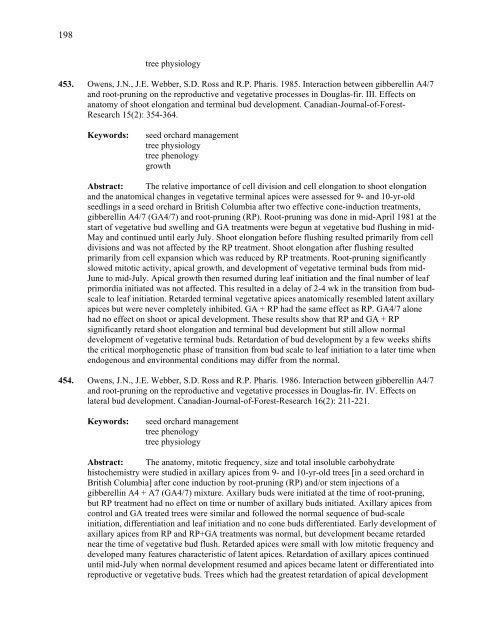IntensIve sIlvIculture - Forest Science Labs - Research Network ...
IntensIve sIlvIculture - Forest Science Labs - Research Network ...
IntensIve sIlvIculture - Forest Science Labs - Research Network ...
Create successful ePaper yourself
Turn your PDF publications into a flip-book with our unique Google optimized e-Paper software.
198<br />
tree physiology<br />
453. Owens, J.N., J.E. Webber, S.D. Ross and R.P. Pharis. 1985. Interaction between gibberellin A4/7<br />
and root-pruning on the reproductive and vegetative processes in Douglas-fir. III. Effects on<br />
anatomy of shoot elongation and terminal bud development. Canadian-Journal-of-<strong>Forest</strong>-<br />
<strong>Research</strong> 15(2): 354-364.<br />
Keywords: seed orchard management<br />
tree physiology<br />
tree phenology<br />
growth<br />
Abstract: The relative importance of cell division and cell elongation to shoot elongation<br />
and the anatomical changes in vegetative terminal apices were assessed for 9- and 10-yr-old<br />
seedlings in a seed orchard in British Columbia after two effective cone-induction treatments,<br />
gibberellin A4/7 (GA4/7) and root-pruning (RP). Root-pruning was done in mid-April 1981 at the<br />
start of vegetative bud swelling and GA treatments were begun at vegetative bud flushing in mid-<br />
May and continued until early July. Shoot elongation before flushing resulted primarily from cell<br />
divisions and was not affected by the RP treatment. Shoot elongation after flushing resulted<br />
primarily from cell expansion which was reduced by RP treatments. Root-pruning significantly<br />
slowed mitotic activity, apical growth, and development of vegetative terminal buds from mid-<br />
June to mid-July. Apical growth then resumed during leaf initiation and the final number of leaf<br />
primordia initiated was not affected. This resulted in a delay of 2-4 wk in the transition from budscale<br />
to leaf initiation. Retarded terminal vegetative apices anatomically resembled latent axillary<br />
apices but were never completely inhibited. GA + RP had the same effect as RP. GA4/7 alone<br />
had no effect on shoot or apical development. These results show that RP and GA + RP<br />
significantly retard shoot elongation and terminal bud development but still allow normal<br />
development of vegetative terminal buds. Retardation of bud development by a few weeks shifts<br />
the critical morphogenetic phase of transition from bud scale to leaf initiation to a later time when<br />
endogenous and environmental conditions may differ from the normal.<br />
454. Owens, J.N., J.E. Webber, S.D. Ross and R.P. Pharis. 1986. Interaction between gibberellin A4/7<br />
and root-pruning on the reproductive and vegetative processes in Douglas-fir. IV. Effects on<br />
lateral bud development. Canadian-Journal-of-<strong>Forest</strong>-<strong>Research</strong> 16(2): 211-221.<br />
Keywords: seed orchard management<br />
tree phenology<br />
tree physiology<br />
Abstract: The anatomy, mitotic frequency, size and total insoluble carbohydrate<br />
histochemistry were studied in axillary apices from 9- and 10-yr-old trees [in a seed orchard in<br />
British Columbia] after cone induction by root-pruning (RP) and/or stem injections of a<br />
gibberellin A4 + A7 (GA4/7) mixture. Axillary buds were initiated at the time of root-pruning,<br />
but RP treatment had no effect on time or number of axillary buds initiated. Axillary apices from<br />
control and GA treated trees were similar and followed the normal sequence of bud-scale<br />
initiation, differentiation and leaf initiation and no cone buds differentiated. Early development of<br />
axillary apices from RP and RP+GA treatments was normal, but development became retarded<br />
near the time of vegetative bud flush. Retarded apices were small with low mitotic frequency and<br />
developed many features characteristic of latent apices. Retardation of axillary apices continued<br />
until mid-July when normal development resumed and apices became latent or differentiated into<br />
reproductive or vegetative buds. Trees which had the greatest retardation of apical development
















